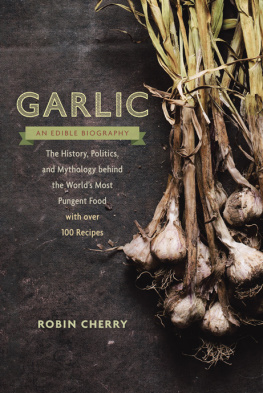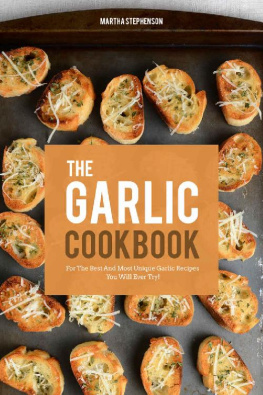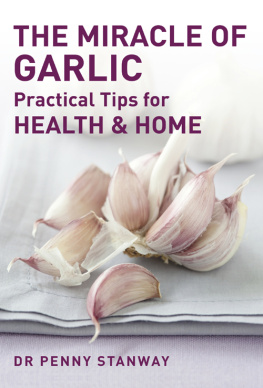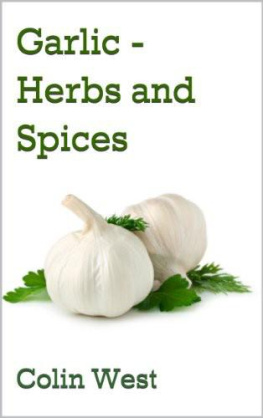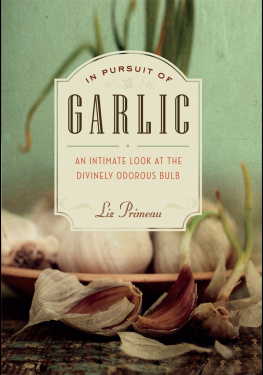Garlic lovers unite! No other allium has been as maligned and rebuffed throughout history as this stinky bulb. Yet its powerful medicinal benefits have been touted for centuries. This masterful work integrates the history, legends, lore, and even vampire tales of garlic, along with an inspired selection of recipes from condiments to desserts. A must-have book for a cooks library.
Diane Morgan, author of Roots: The Definitive Compendium
This lovely historical and international tour of the many faces of garlic, with enticing recipes, is a wonderful resource for anyone interested in learning to use garlic in more ways in their kitchen.
Tama Matsuoka Wong, author of Foraged Flavor and forager for the restaurant Daniel
ABOUT THE BOOK
Garlic is the Lord Byron of produce, a lusty rogue that charms and seduces you, but runs off before dawn leaving a bad taste in your mouth. Called everything from rustic cure-all to Russian penicillin, Bronx vanilla, and Italian perfume, garlic has been loved, worshiped, and despised throughout history. Robin Cherrys Garlic is an edible biography of one of the foundational ingredients of world cooking. While this book does not claim that garlic saved civilization (though it might cure whatever ails you), it does take us on a grand tour of garlics fascinating role in history, medicine, literature, and art; its controversial role in bigotry, mythology, and superstition; and its indispensable contribution to the great cuisines of the world. But just to make sure the appetite doesnt feel slighted, over 100 recipes that feature garlic are included too, from Italys Pasta Aglio Olio to Chinas Good Fortune Garlic Lettuce. Garlic is a compelling story about an elemental, earthy, and rustic food with truly deep roots.
Travel writer and historian ROBIN CHERRY is the author of Catalog: The Illustrated History of Mail Order Shopping. She was the publisher of Organic Style books and the circulation director of Organic Gardening and Organic Style magazines at Rodale. She has written for The Atlantic, Travel + Leisure, Dwell, Salon, and many other publications and websites. As a travel writer, she has already visited many of the places featured in Garlic, including India, China, the Middle East, Russia, Europe, and Gilroy, California.
Sign up to receive free projects and special offers from Roost Books.

Or visit us online to sign up at roostbooks.com/eroost.
We remember the fish, which we did eat in Egypt freely; the cucumbers, and the melons, and the leeks, and the onions, and the garlick.
The Holy Bible (King James Version), Numbers 11

And, most dear actors, eat no onions nor garlic, for we are to utter sweet breath.
William Shakespeare, A Midsummer Nights Dream, act 4, scene 2

A nickel will get you on the subway, but garlic will get you a seat.
Yiddish proverb

an Edible Biography

THE HISTORY, POLITICS, AND MYTHOLOGY BEHIND THE WORLDS MOST PUNGENT FOOD, WITH OVER 100 RECIPES
Robin Cherry

ROOST BOOKS
Boston
2014
Roost Books
An imprint of Shambhala Publications, Inc.
Horticultural Hall
300 Massachusetts Avenue
Boston, Massachusetts 02115
roostbooks.com
Cover design by Jim Zaccaria
Cover photograph by Michael Piazza
2014 by Robin Cherry
Recipes by Mary Deir Donovan
All rights reserved. No part of this book may be reproduced in any form or by any means, electronic or mechanical, including photocopying, recording, or by any information storage and retrieval system, without permission in writing from the publisher.
LIBRARY OF CONGRESS CATALOGING-IN-PUBLICATION DATA
Cherry, Robin.
Garlic, an edible biography: the history, politics, and mythology behind the worlds most pungent food: with over 100 recipes / Robin Cherry.
pages cm
eISBN 978-0-8348-2994-7
ISBN 978-1-61180-160-6 (paperback)
1. Cooking (Garlic)History. 2. Garlic. I. Title.
TX819.G3C45 2014
641.3526dc23
2014007482
Contents
Garlic is the Lord Byron of produce, a lusty rogue that charms and seduces you but runs off before dawn, leaving a bad taste in your mouth. Yet despite its powers of seduction, garlic itself is asexual, grown from cloves without pollination. Called everything from rustic cure-all and Russian penicillin to Bronx vanilla and Italian perfume, the sulfurous bulb has permeated the history of mankind (literally) and been variously loved, worshiped, defamed, and despised. King Henry IV of France was baptized with it, and corpses were embalmed with it. Its credited with curing everything from baldness and scurvy to cancer and the plague and is one of the few products used in the worlds three major ancient healing systems: Indian Ayurveda, traditional Chinese medicine, and traditional European medicine.
People throughout the world rely on garlics powers of protection, and its said to ward off vampires and other evil spirits, to protect babies and Belizean cab drivers, to bring luck to soldiers and jockeys, and according to Swedish farmers, to protect cows from trolls.
Sadly, garlic has also been used to discriminate against different ethnic and religious groups, especially Jews, Italians, and Koreans, and garlic eaters has been used as a derogatory slur for centuries. Today, with attendance at Gilroy, Californias annual garlic festival topping 100,000, its hard to think of garlic eater as an insult. A love for garlic has become a point of pride. Youve probably never been to a carrot festival, but garlic festivals take place throughout the world from Gilroy, California, and the Hudson Valley, New York, to the Isle of Wight, United Kingdom, and Takko-Machi, Japan. Other foods may have fans; garlic has lovers.
Like many people who grew up in the 1960s and 70s, I have Julia Child to thank for introducing me to garlic. Or more precisely, I have Julia Child to thank for introducing my mother to garlic. When Childs The French Chef came on public television on Wednesday nights, Mom retreated to her bedroom, leaving Dad in charge of my sister and me. She closed the door and, like an eager student, scrawled notes in the margins of her new, 800-page copy of Mastering the Art of French Cooking. I still have the well-worn book with Moms double check marks denoting our favorite recipes, which included Childs legendary mashed potatoes with thirty cloves of garlic. While Mom cooked her way through the book, she wore a blue and white striped apron with a red pocket that said, Thank you, Julia Child! I couldnt agree more.
Child would repeatedly assure her readers and viewers that they should no longer avoid garlic as something suspiciously foreign, probably subversive, and certainly very lower-class. From her homey kitchen in Cambridge, Massachusetts, she started nothing less than a culinary revolution, rescuing garlic from its onetime confinement in old ethnic and urban communities and unleashing it on suburban kitchens throughout the country.
Next page
